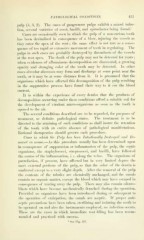Page 433 - My FlipBook
P. 433
PATHOLOGICAL CONDITIONS. 431
pulp (4, 3, 2). The cases of gangrenous pulps exhibit a mixed infec-
tion, several varieties of cocci, bacilli, and spirochc^etes being found.'
Cases are occasionally seen in which the pulp of a non-carious tooth
has been devitalized in consequence of a blow, injuring the vessels as
they enter the apex of the root ; the same effect is not rare as a conse-
quence of too rapid or extensive movement of teeth in regulating. The
pulps in such cases are probably destroyed by thrombosis of the vessels
at the root apex. The death of the pulp may not be detected for years ;
when evidences of albuminous decomposition are discovered, a growing
opacity and changing color of the tooth may be detected. In other
cases alveolar abscesses may form and discharge at some point near the
tooth, or it may be at some distance from it. It is presumed that the
organisms which have effected this decomposition of the pulp resulting
in the suppurative process have found their way to it via the blood
current.
It is within the experience of every dentist that the products of
decomposition occurring under these conditions afford a suitable soil for
the development of virulent micro-organisms as soon as the tooth is
opened to the air.
The several conditions described are to be regarded, for purposes of
treatment, as definite pathological states. The treatment is to be
directed to the attaining of such conditions as shall insure the retention
of the tooth with an entire absence of pathological manifestations.
Rational therapeutics should govern each procedure.
Cases in ivhich the Pulp has been Intentionally Destroyed and Re-
moved en masse.—As this procedure usually has been determined upon
in consequence of suppuration or inflammation of the pulp, the septic
organisms, the staphylococci, streptococci, and bacilli, have followed
the course of the inflammation, /. e. along the veins. The organisms of
putrefaction, if present, have affected but in very limited degree the
most external portions of the pulp, so that the color of the dentin is
unaltered except to a very slight depth. After the removal of the pulp
the contents of the tubules are chemically unchanged, and the canals
contain no organic matter, except the blood which may have escaped in
consequence of tearing away the pulp. There may also remain odonto-
blasts which have become mechanically detached during the operation.
Provided no organisms have been introduced during or subsequent to
the operation of extirpation, the canals are aseptic. If proper anti-
septic precautions have been taken, sterilizing and isolating the tooth to
be operated on and also the instruments employed, no infection occurs.
These are the cases in which immediate root filling has been recom-
mended and practised with success.
' See Fig. 397.


